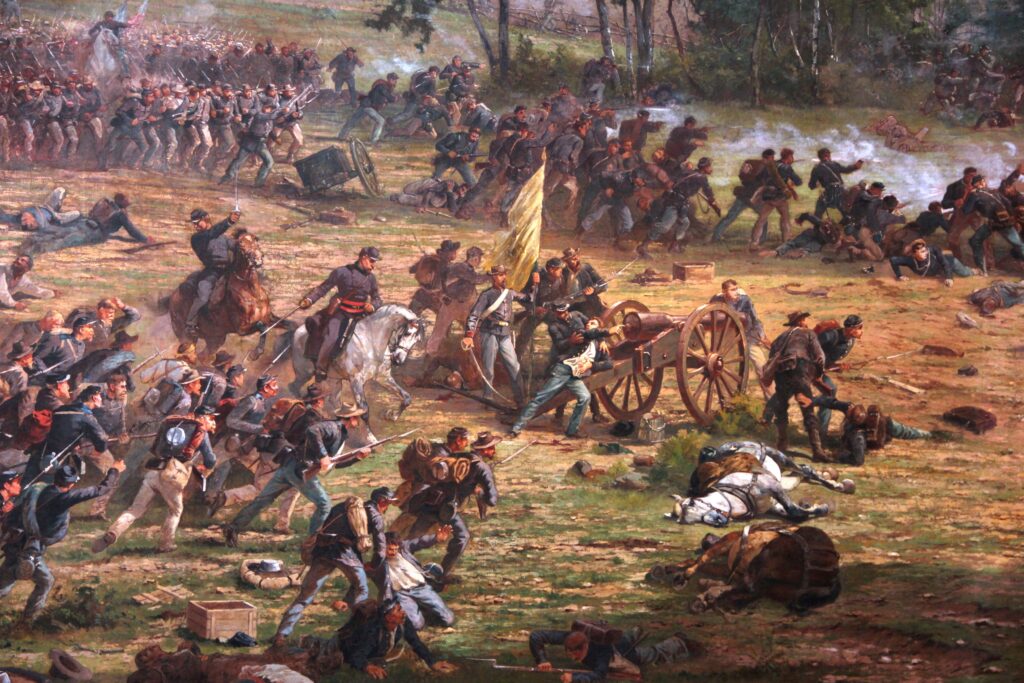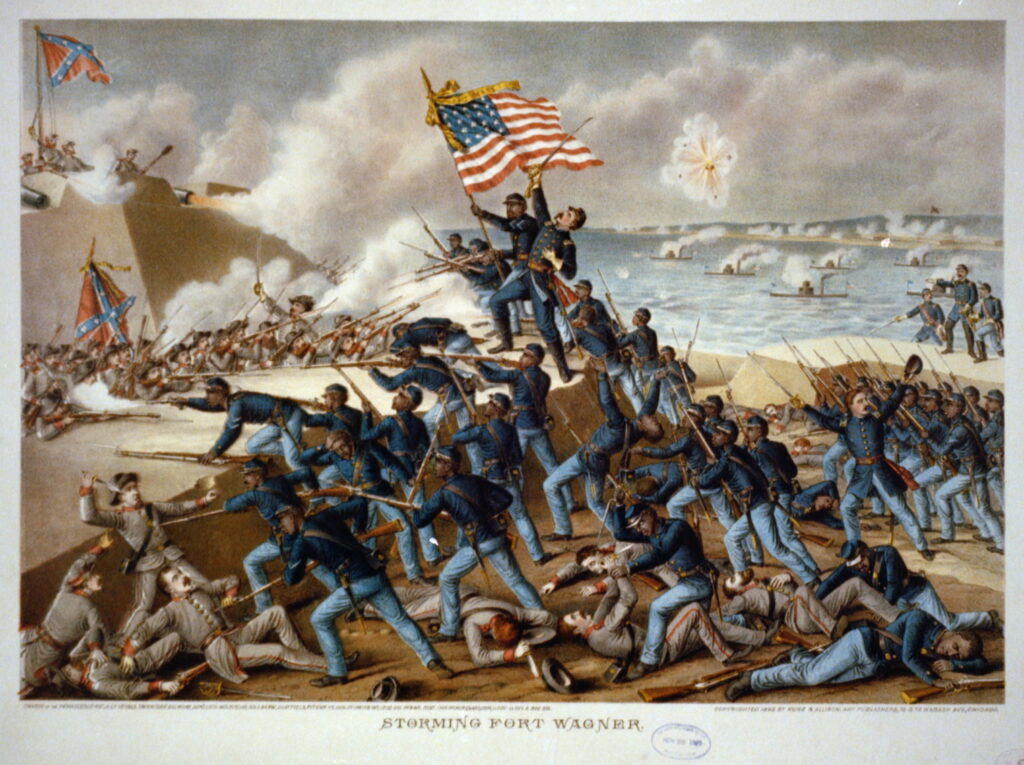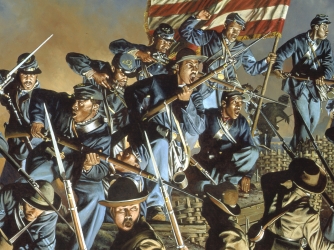
Towards Gettysburg
Towards Gettysburg
After the Battle of Antietam, Lee’s forces retreated into Virginia’s Shenandoah Valley with almost no interference. Frustrated by McClellan’s lack of aggressiveness, Lincoln replaced him with General Ambrose E. Burnside. In December 1862, Burnside attacked 73,000 Confederate troops at Fredericksburg, Virginia. Six times Burnside launched frontal assaults on Confederate positions. The Union Army suffered nearly 13,000 casualties, twice the number suffered by Lee’s men, severely damaging Northern morale.
After the defeat at Fredericksburg, Lincoln removed Burnside and replaced him with Joseph Hooker. In May 1863, Hooker tried to attack Lee’s forces from a side or flanking position. In just ten minutes, Confederate forces routed the Union Army at the Battle of Chancellorsville. But, the Confederate victory came at a high cost. Lee’s ablest lieutenant, Stonewall Jackson, was accidentally shot by a Confederate sentry and died of a blood clot.
Despite Confederate victories at Fredericksburg and Chancellorsville, the Union showed no signs of giving up. In a bid to shatter Northern morale and win European recognition, Lee’s army launched a daring invasion of Pennsylvania.
When his forces drove northward into Pennsylvania, Lee assumed, mistakenly, that Union forces were still in Virginia. When he suddenly realized that Union forces were in close pursuit, he ordered his forces, which were strung out from Maryland to Harrisburg, Pennsylvania, to converge at Gettysburg, Pennsylvania, a central location where a number of roads met. Lee, who did not want to risk a battle until he had gathered all his troops together, ordered his men not to engage the enemy. On July 1, 1863, however, a Confederate brigade ran into Union cavalry near Gettysburg and the largest battle ever fought in the West Hemisphere broke out before anyone realized what was happening.
The Battle of Gettysburg
On the evening of July 1, most of Lee’s army of 75,000 reached Gettysburg. Meanwhile, most of the 90,000-man Union army of General George Meade arrived at Gettysburg that same evening.

On July 2, Lee tried to attack Union positions from the left and right flanks, but Northern troops repelled the attack. The next day, the Union army, which expected Lee to attack again on the flanks, reinforced its flanks. Lee launched a frontal attack on the center of the Union lines, which came as a shock. However, a frontal assault against a well-fortified defensive position on a hill was very unlikely to succeed. Some 15,000 Confederate troops, led by General George E. Pickett, marched three-quarters of a mile into withering Union rifle and artillery fire. Although about a hundred Confederate soldiers succeeded in temporarily breaking through the Union defenses, the Northern lines held firm. When Lee finally ordered a retreat back into Virginia, it became clear that the Confederacy had suffered a disastrous defeat. Nearly 25,000 Confederate soldiers were killed, wounded, or missing in action at the Battle of Gettysburg. After Gettysburg, Lee was never able to mount another major offensive.
The New York City Draft Riots
Two weeks after the Battle of Gettysburg was waged, the worst mob violence of U.S. history took place in New York City. As the Civil War dragged on, enthusiasm faded and class tensions flared. About 120 people were killed, mainly by police and soldiers. Irish Catholic immigrants and their children had been egged on by Democratic leaders who told them that Republicans wanted to free the slaves in order bring them north to replace Irish workers. During four days of rioting, mobs lynched at least a dozen African American men, destroyed draft offices, burned and looted black neighborhoods and the homes of leading Republicans and abolitionists.
Union troops which had fought at Gettysburg were redeployed to New York City to help suppress the draft riots.
Vicksburg
The four days between July 1, and July 4, 1863 marked a major turning point of the Civil War. Beginning in mid-May, Ulysses S. Grant’s troops began a siege of Vicksburg, Mississippi. Located on a bluff overlooking the Mississippi, Vicksburg allowed the Confederacy to control river traffic between Memphis and New Orleans. The day after the defeat of Lee’s army at Gettysburg, Vicksburg surrendered. Five days later, Union forces captured Port Hudson, Louisiana. These victories gave the North complete control of the Mississippi River and isolated Confederate territory west of the Mississippi from areas east of the river.
After the defeats at Gettysburg and Vicksburg, Southern morale began to sag. Despite military defeats, inflation, shortages, desertions, the flight of thousands of slaves, and flagging resolve, however, the Confederacy continued to fight for another 22 months.
Blacks in Blue
By early 1863, voluntary enlistments in the Union Army had fallen so sharply that the federal government instituted an unpopular military draft and decided to enroll black, as well as white, troops. It seems likely that it was the availability of large numbers of African American soldiers that allowed President Lincoln to resist demands for a negotiated peace that might have including the retention of slavery in the United States. Altogether, 186,000 black soldiers served in the Union Army and another 29,000 served in the Navy, accounting for nearly ten percent of all Union forces and 68,178 of the Union dead or missing. Twenty-four African Americans received the Congressional Medal of Honor for extraordinary bravery in battle.
Three-fifths of all black troops were former slaves. The active participation of black troops in the fighting made it far less likely that African Americans would remain in slavery after the Civil War.
While some white officers, like Robert Gould Shaw, who commanded the 54th Massachusetts Regiment, were proud to lead black troops in battle, others exhibited a deep resistance.
Fort Wagner

Black soldiers participated in the war at great threat to their lives. The Confederate government threatened to summarily execute or sell into slavery any captured black Union soldiers—and did sometimes carry out those threats. Lincoln responded by threatening to retaliate against Confederate prisoners whenever black soldiers were killed or enslaved.
In July 1863, the 54th Massachusetts Infantry, the first black regiment raised in the North, led an assault against Fort Wagner, which guarded Charleston, South Carolina’s harbor. Two of Frederick Douglass’s sons were members of the regiment. Over forty percent of the regiment’s members were killed or wounded in the unsuccessful attack, including Colonel Robert Gould Shaw, a member of a prominent antislavery family, who was shot dead in the charge.
The Battle Against Discrimination
During the war, African American troops also faced a different kind of battle: a battle against discrimination in pay, promotions, and medical care. Despite promises of equal treatment, blacks were relegated to separate regiments commanded by white officers. Black soldiers received less pay than white soldiers, inferior benefits, and poorer food and equipment. While a white private was paid $13 a month plus a $3.50 clothing allowance, blacks received $10 a month, out of which $3 was deducted for clothing. Furthermore, black soldiers were not provided with the enlistment bonuses commonly given to white soldiers, and, until the end of the war, the federal government refused to commission black officers.

Within the ranks, black troops faced repeated humiliations. Most were employed in menial assignments and kept in rear-echelon, fatigue jobs. They were punished by whipping or by being tied by their thumbs. If captured by the Confederates, they faced execution. Despite these trials, African American soldiers won their fight for equal pay in 1864. In 1865, they were allowed to serve as line officers. Drawing upon the education and training they received in the military, former troops became community leaders during Reconstruction.
One Union captain explained the significance of black military participation on the attitudes of white soldiers. “A great many [white people],” he wrote, “have the idea that the entire Negro race are vastly their inferiors. A few weeks of calm unprejudiced life here would disabuse them, I think. I have a more elevated opinion of their abilities than I ever had before. I know that many of them are vastly the superiors of those…who would condemn them to a life of brutal degradation.”